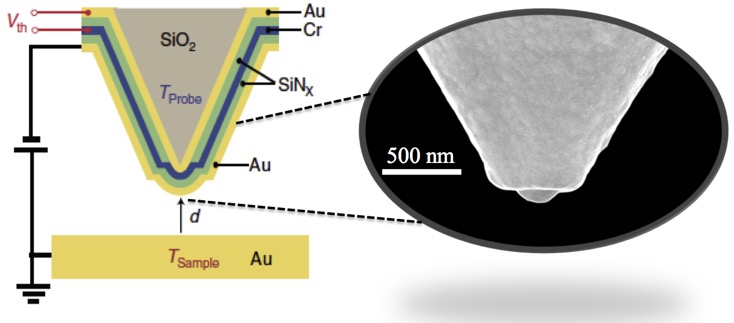Radiative heat transfer in the extreme near-field regime
15/02/17 18:01
Radiative heat transfer between closely placed objects is attracting a lot attention for several reasons. First, recent experiments have finally verified the long-standing prediction that radiative heat transfer can be greatly enhanced over the classical far-field limit set by the Stefan-Boltzmann law for blackbodies if the gap between two objects is smaller than the thermal wavelength, which is of the order of 10 microns at room temperature This is possible due to the contribution of the near field in the form of evanescent waves (or photon tunneling). Second, this confirmation has triggered the hope that near-field radiative heat transfer could have an impact in different technologies that make use of thermal radiation such as thermophotovoltaics, thermal management, lithography, data storage, and thermal microscopy.
In spite of the progress made in recent years in the understanding of thermal radiation at the nanoscale, several recent experiments exploring the radiative thermal transport in nanometric gaps have seriously questioned this understanding. In particular, measurements on two gold-coated surfaces with gap sizes in the range of 0.2-10 nm have suggested an extraordinarily large near-field enhancement more than 3 orders of magnitude larger than the predictions of fluctuational electrodynamics, which is presently the standard theory used for the description of near-field thermal radiation.
We now propose a possible solution to this puzzle in a work published in Nature Communications in collaboration with the groups of Pramod Reddy and Edgar Meyhofer (University of Michigan) and Víctor Fernández-Hurtado, Johannes Feist, and Francisco J. Garcia-Vidal. In this work, we explore the radiative heat transfer in Ångström- and nanometer-sized gaps between an Au-coated scanning thermal microscopy probe and a planar Au substrate in an ultrahigh vacuum environment. Using the apparent tunneling barrier height as a measure of cleanliness, we found that upon systematically cleaning via plasma-cleaning or locally pushing the tip into the substrate by a few nanometers, the observed radiative conductances decreased from unexpectedly large values to extremely small ones, below the detection limit of the probe, as expected from our computational results obtained within the framework of fluctuational electrodynamics. These results suggest that the huge signal reported in recent experiments might be an artifact due to the presence of contaminants bridging the gap between the tip and the substrate, thus providing an additional path for heat transfer via conduction. Moreover, this work shows that it is possible to avoid the confounding effects of surface contamination and systematically study thermal radiation in Ångström- and nanometer-sized gaps.

In spite of the progress made in recent years in the understanding of thermal radiation at the nanoscale, several recent experiments exploring the radiative thermal transport in nanometric gaps have seriously questioned this understanding. In particular, measurements on two gold-coated surfaces with gap sizes in the range of 0.2-10 nm have suggested an extraordinarily large near-field enhancement more than 3 orders of magnitude larger than the predictions of fluctuational electrodynamics, which is presently the standard theory used for the description of near-field thermal radiation.
We now propose a possible solution to this puzzle in a work published in Nature Communications in collaboration with the groups of Pramod Reddy and Edgar Meyhofer (University of Michigan) and Víctor Fernández-Hurtado, Johannes Feist, and Francisco J. Garcia-Vidal. In this work, we explore the radiative heat transfer in Ångström- and nanometer-sized gaps between an Au-coated scanning thermal microscopy probe and a planar Au substrate in an ultrahigh vacuum environment. Using the apparent tunneling barrier height as a measure of cleanliness, we found that upon systematically cleaning via plasma-cleaning or locally pushing the tip into the substrate by a few nanometers, the observed radiative conductances decreased from unexpectedly large values to extremely small ones, below the detection limit of the probe, as expected from our computational results obtained within the framework of fluctuational electrodynamics. These results suggest that the huge signal reported in recent experiments might be an artifact due to the presence of contaminants bridging the gap between the tip and the substrate, thus providing an additional path for heat transfer via conduction. Moreover, this work shows that it is possible to avoid the confounding effects of surface contamination and systematically study thermal radiation in Ångström- and nanometer-sized gaps.

